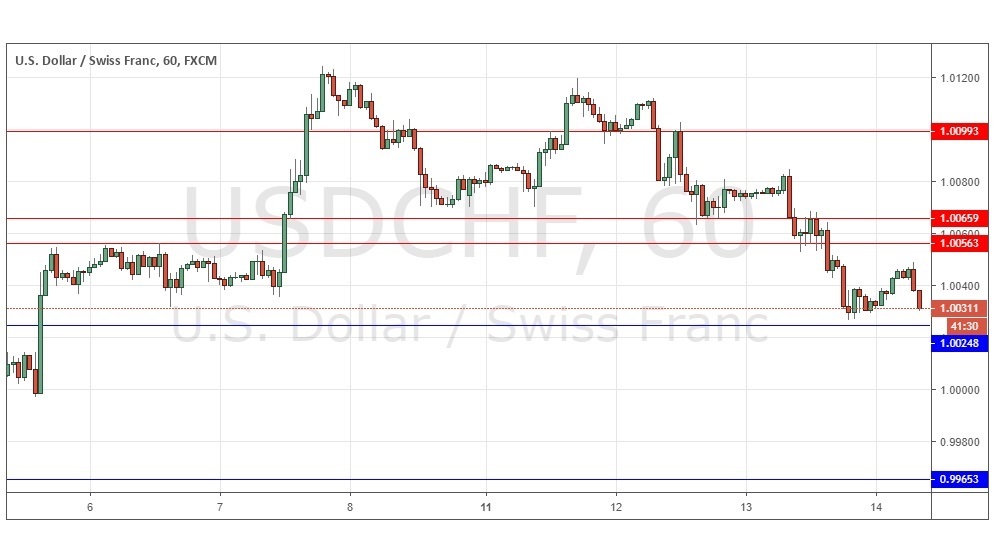Yesterday’s signals might have produced a losing long trade at 1.0058 although the action here wasn’t really bullish enough to justify a long entry – much depended upon interpretation.
Today’s USD/CHF Signals
Risk 0.75%.
Trades may only be taken before 5pm London time today.
Short Trades
-
Short entry following a bearish price action reversal upon the next touch of 1.0056 or 1.0066.
-
Put the stop loss 1 pip above the local swing high.
-
Move the stop loss to break even once the trade is 20 pips in profit.
-
Remove 50% of the position as profit when the price reaches 20 pips in profit and leave the remainder of the position to run.
Long Trades
-
Long entry following a bullish price action reversal upon the next touch of 1.0025 or 0.9965.
-
Put the stop loss 1 pip below the local swing low.
-
Move the stop loss to break even once the trade is 20 pips in profit.
-
Remove 50% of the position as profit when the price reaches 20 pips in profit and leave the remainder of the position to run.
The best method to identify a classic “price action reversal” is for an hourly candle to close, such as a pin bar, a doji, an outside or even just an engulfing candle with a higher close. You can exploit these levels or zones by watching the price action that occurs at the given levels.
USD/CHF Analysis
I wrote yesterday that in the unlikely event that the price broke above 1.0125 later today, I would take a bullish bias at that point. Otherwise, trading any firm rejection of a key level in the direction of the rejection was likely to be the best trading strategy to take. I was right about not being bullish below 1.0125, and the rejection at 1.0058 was arguably not “firm” but could have been interpreted that way.
The picture now is more bearish, with the former support at 1.0058 flipping to become new lower resistance, but the support at 1.0025 still looks strong and has not yet been tested. I think a long trade here if there is a firm bounce at 1.0025 later could be a good potential trade, but a short off the 1.0056 area could also be a good short trade. I’d take a bearish bias if the price gets established below 1.0025 and a bullish bias if above 1.0066.
There is nothing of high importance due today concerning the CHF or the USD.
Recommended Content
Editors’ Picks
EUR/USD: The first upside target is seen at the 1.0710–1.0715 region

The EUR/USD pair trades in positive territory for the fourth consecutive day near 1.0705 on Wednesday during the early European trading hours. The recovery of the major pair is bolstered by the downbeat US April PMI data, which weighs on the Greenback.
GBP/USD rises to near 1.2450 despite the bearish sentiment

GBP/USD has been on the rise for the second consecutive day, trading around 1.2450 in Asian trading on Wednesday. However, the pair is still below the pullback resistance at 1.2518, which coincides with the lower boundary of the descending triangle at 1.2510.
Gold price struggles to lure buyers amid positive risk tone, reduced Fed rate cut bets

Gold price lacks follow-through buying and is influenced by a combination of diverging forces. Easing geopolitical tensions continue to undermine demand for the safe-haven precious metal. Tuesday’s dismal US PMIs weigh on the USD and lend support ahead of the key US data.
Crypto community reacts as BRICS considers launching stablecoin for international trade settlement

BRICS is intensifying efforts to reduce its reliance on the US dollar after plans for its stablecoin effort surfaced online on Tuesday. Most people expect the stablecoin to be backed by gold, considering BRICS nations have been accumulating large holdings of the commodity.
US versus the Eurozone: Inflation divergence causes monetary desynchronization

Historically there is a very close correlation between changes in US Treasury yields and German Bund yields. This is relevant at the current juncture, considering that the recent hawkish twist in the tone of the Fed might continue to push US long-term interest rates higher and put upward pressure on bond yields in the Eurozone.
